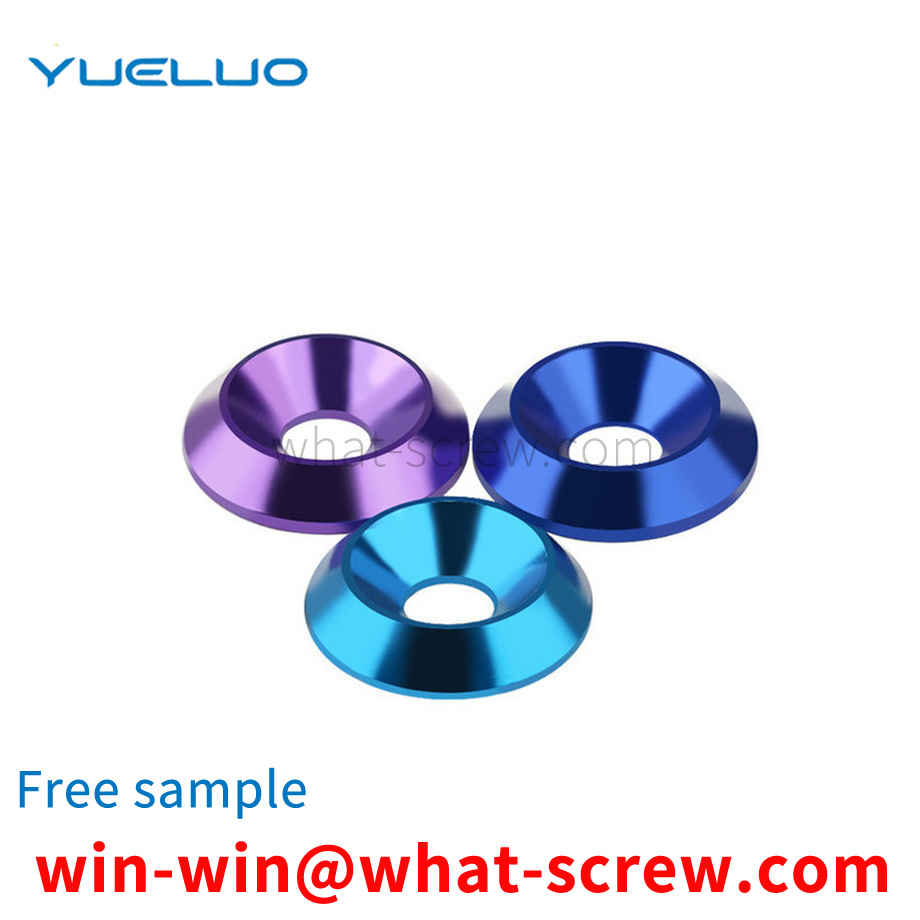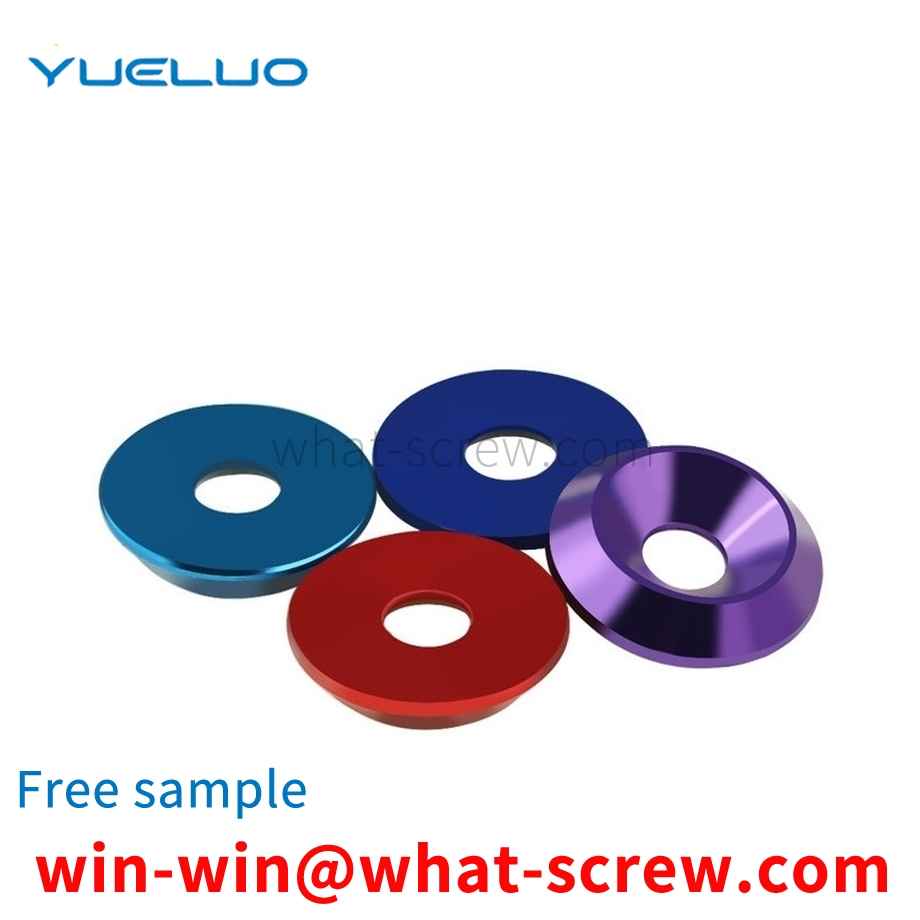An asphalt pavement screw, the asphalt pavement screw includes a main rod, an outer jacket, a pressing piece and a nut, the main rod is a columnar rod, the lower end of the main rod is provided with a table for supporting the outer jacket, and the middle part of the main rod passes through the outer jacket The upper part of the main rod is provided with a threaded section, the pressing piece and the nut are set on the threaded section, and at least two deformation holes are provided on the outer sleeve, and the middle part of the deformation hole is larger than the upper and lower sides of the deformation hole, The part between the adjacent deformation holes is the deformation part, and the width of the middle part of the deformation part is smaller than the width of the upper and lower sides of the deformation part. After the asphalt pavement screw of Guangdong Yueluo Hardware Industry Co., Ltd. is assembled, it has strong bonding force with the asphalt road. Even if it is hit, it will not be separated from the asphalt road. Using this asphalt pavement screw to fix the road railing can strengthen the road railing. The firmness of the assembly.
The self-tapping locking screw is composed of three parts: the head, the stem and the end of the stem from beginning to end. The composition of each self-tapping screw has four major elements: head shape, wrenching method, thread type, and end type. Head Shapes - Head shapes come in all shapes and sizes. There are round head (semi-round head), oblate head, round head flange (with pad), oblate head flange (with pad), pan head, pan head flange (with pad), countersunk head, semi-countersunk head, Cylinder head, spherical cylinder head, horn head, hexagonal head, hexagonal flange head, hexagonal flange (with gasket), etc. Wrench Styles - There are various ways of wrenching. External wrench: hexagonal, hexagonal flange, hexagonal flange, hexagonal flower shape, etc.; internal wrench: slotted, cross groove H type (Phillips), cross groove Z type (Pozidriv), cross groove F type (Frearson) , Square groove (Scrulox), compound groove, internal spline, internal hexagon flower (plum groove), internal triangle, internal hexagon, internal 12-angle, clutch groove, six-blade groove, high torque cross groove and so on. Thread Types - There are many types of threads. There are self-tapping threads (wide thread), machine threads, drywall screw threads, fiberboard screw threads, and some other special threads. In addition, the thread can be divided into single lead (single head), double lead (double head), multi-lead (multiple head) and high and low thread double head thread. End type - The end type mainly includes saw end and flat end. However, according to the function of use, grooves, grooves, incisions or parts with a cutting function can be processed. In some standards, the same saw end or flat end, there are different forms. There are various changes in the head shape, wrenching method, thread type and shank end type of self-tapping screws. They can be combined with each other to show many different products belonging to the category of self-tapping screws.
The quality of electroplating is measured primarily by its corrosion resistance, followed by appearance. Corrosion resistance is to imitate the working environment of the product, set it as the test condition, and perform a corrosion test on it. The quality of electroplating products shall be controlled from the following aspects: 1. Appearance: Partial uncoated, scorched, rough, gray, peeling, crusted, and obvious stripes are not allowed on the surface of the product, and pinholes, pitting, and black plating are not allowed. Slag, loose passivation film, cracks, peeling off and serious passivation marks. 2. Coating thickness: The operating life of fasteners in corrosive atmosphere is proportional to its coating thickness. The general recommended thickness of economical electroplating coating is 0.00015in ~ 0.0005in (4 ~ 12um). Hot-dip galvanizing: the standard average thickness is 54 um (43 um for diameter ≤ 3/8), and the minimum thickness is 43 um (37 um for diameter ≤ 3/8). 3. Coating distribution: With different deposition methods, the aggregation method of the coating on the surface of the fastener is also different. During electroplating, the coating metal is not uniformly deposited on the peripheral edge, and a thicker coating is obtained at the corners. In the threaded portion of the fastener, the thickest coating is located on the thread crest, gradually thinning along the flank of the thread, and the thinnest deposit is at the bottom of the thread, while hot dip galvanizing is just the opposite, the thicker coating is deposited on the inside corners and On the bottom of the thread, mechanical plating tends to deposit the same metal as hot-dip plating, but is smoother and has a much more uniform thickness over the entire surface [3]. 4. Hydrogen embrittlement: During the processing and processing of fasteners, especially in the pickling and alkali washing before plating and the subsequent electroplating process, the surface absorbs hydrogen atoms, and the deposited metal coating then traps hydrogen. When the fastener is tightened, the hydrogen is transferred towards the most stressed parts, causing the pressure to build up beyond the strength of the base metal and producing microscopic surface cracks. Hydrogen is particularly active and quickly seeps into the newly formed fissures. This pressure-rupture-penetration cycle continues until the fastener breaks. Usually occurs within a few hours after the first stress application. To eliminate the threat of hydrogen embrittlement, fasteners are heated and baked as soon as possible after plating to allow hydrogen to seep out of the plating, typically at 375-4000F (176-190C) for 3-24 hours. Since mechanical galvanizing is non-electrolyte, this virtually eliminates the threat of hydrogen embrittlement, which exists in galvanizing using electrochemical methods. In addition, due to engineering standards, it is forbidden to hot-dip galvanize fasteners with hardness higher than HRC35 (Imperial Gr8, metric 10.9 and above). Therefore, hydrogen embrittlement rarely occurs in hot-dip plated fasteners. 5. Adhesion: Cut or pry off with a solid tip and considerable pressure. If, in front of the blade tip, the coating peels off in flakes or skins, exposing the base metal, the adhesion shall be considered insufficient.
Guangdong Yueluo Hardware Industry Co., Ltd. provides a Otagoshaft retaining ring in order to solve the above problems. The plan of Guangdong Yueluo Hardware Industry Co., Ltd. is a Otagoshaft retaining ring realized in this way, which is composed of a shaft washer, a torsion spring, a positioning pin and a limit pin. It is characterized in that the shaft washer is provided with two symmetrical distribution gaps. a circular ring, and a groove is provided at the vertical notch on one side, and a stepped through hole is provided on the side notch facet of the groove to cooperate with the limit pin, and the two sides of the groove are provided with a through hole and a locating pin Matching; the limit pin is a stepped short shaft. The beneficial effects of Guangdong Yueluo Hardware Industry Co., Ltd. are simple structure, low production cost, convenient and reliable use.
There are many types of rivets, including dome head, flat head, Otagoblind rivet and so on. When riveting parts, they will have uneven force and affect the quality of riveting. Some rivet caps are too thin to easily affect the quality of riveting. Some rivets have poor tightness of riveted parts when riveting. Therefore, both the structure of the rivet and the tightness of the riveting need to be considered, so as to enhance the quality of the rivet fastening.
We have many years of experience in the production and sales of screws, nuts, flat washers, etc. The main products are: green screws, nut Otagoring nuts, 304 cross flat head bolts, thin lock nuts and other products, we can provide you with suitable tightening nuts and other products. Firmware Solutions.



















 Service Hotline
Service Hotline




